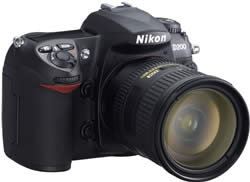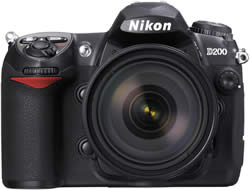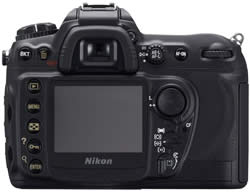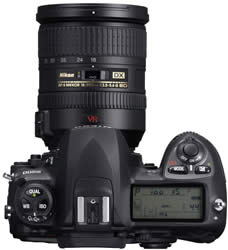Nikon D200 Announced
 The Nikon D200 digital SLR camera is announced today. The Nikon D200 is a 10.2 megapixel DSLR with a 2.5 inch LCD screen and 11-area auto-focus system. Other highlights of the D200 include a magnesium alloy body, 5 frames per second continuous mode and 3D Color Matrix Metering II. The Nikon D200 will cost £1299.99 / €1940 / $1849 body only and will be available at the end of December. Two kits are also available - the D200 and 18-70mm lens is £1499.99 / €2240, and the D200 and 17-55mm lens is £2299.99 / €3435.
The Nikon D200 digital SLR camera is announced today. The Nikon D200 is a 10.2 megapixel DSLR with a 2.5 inch LCD screen and 11-area auto-focus system. Other highlights of the D200 include a magnesium alloy body, 5 frames per second continuous mode and 3D Color Matrix Metering II. The Nikon D200 will cost £1299.99 / €1940 / $1849 body only and will be available at the end of December. Two kits are also available - the D200 and 18-70mm lens is £1499.99 / €2240, and the D200 and 17-55mm lens is £2299.99 / €3435.
Nikon UK Press Release
Nikon launches the D200 Bridging the gap between professionals and enthusiasts
Nikon launches its powerful, feature-packed D200 digital SLR camera, delivering a high-precision, high-performance package and creating a new class of camera between entry-level and professional digital SLRs.
The Nikon D200 combines the solid look and feel and advanced camera operation of Nikon’s D2 professional series with the approved user-friendliness and stunning image quality that are the hallmarks of all Nikon digital SLRs.
The D200 has been crafted to connect a range of newly developed Nikon technologies with advanced features inherited from the Nikon D2x, ensuring an ultimate shooting experience with exceptional and versatile imaging performance, high speed and an instant response. The result is a blend of superb features, high quality components and fantastic results.
This combination makes the D200 perfect for passionate, dedicated amateur photographers, business users in fields such as the police, dentistry and museums and professionals or semi-professionals looking for a second camera to complement their Nikon D2x or D2Hs.
 Solid look and feel
Solid look and feel
The D200 boasts a lightweight, yet durable and robust magnesium alloy body and an advanced sealing system that protects the camera from moisture and dust, making it suitable for a range of rigorous and challenging assignments. The integrated double-bladed shutter, which incorporates a refined mirror balance system, has been tested to well in excess of 100,000 cycles.
Advanced operation
The D200’s camera operation is inherited from the Nikon D2x, and boasts more than 40 well organised custom settings, so it is ideally suited to the user’s needs and preferences. The large, bright viewfinder offers a great 0,94x magnification and 95% frame coverage both horizontally and vertically to guarantee exceptionally detailed viewing control.
A 2.5 inch high resolution LCD screen provides an ultra-wide 170° viewing angle from all directions. Images on the D200 can be magnified by up to 400% so users can check for fine detail, adding to the rich and varied experience.
The top LCD panel is the largest in the industry, containing a wealth of data such as shooting mode, battery condition, card information, gridline display, shutter speed, F stop and shots remaining. A new colour-coded menu display facilitates easy viewing, supported by intuitive keywords to assist speedy navigation.
The newly-developed high-energy EN-EL3e rechargeable lithium-ion battery delivers enough power to the D200 to support the shooting of up to 1,800 images on a single charge, which takes no longer than 2.5 hours. Battery status can be checked through a real-time fuel gauge system, found in the menu. An optional MB-D200 battery pack extends shooting capability, using AA-size batteries (six are needed) or two NE-EL3e’s.
 Ultimate shooting experience
Ultimate shooting experience
The D200 is ideal for capturing unexpected or fleeting moments, thanks to the 0.15 second power-up, a speedy shutter lag time of just 50 milliseconds and a shortened viewfinder blackout time of 105 milliseconds.
The D200 is also capable of ultra high-speed continuous shooting of five frames per second, capturing up to 37* pictures in JPEG or 22* in RAW format. A newly developed and highly flexible Multi - CAM1000 Autofocus features a pinpoint 11-area AF system inherited from Nikon D2 series as well as a 7-wide area AF to focus on larger moving objects easily.
*When using a SanDisk SDCFH (Ultra II) or SDCFX (Extreme III) 1GB CF card.
Another feature inherited from the D2X is the 3D-Colour Matrix Metering II, which delivers optimised exposure using new technology developed for the Nikon 1,005 pixel RGB exposure/Colour Matrix Metering sensor. This system evaluates seven parameters in every shot – including brightness, colour, contrast, selected focus area, camera-to-subject distance - and references this data against an on-board database of over 30,000 actual photographic scenes to instantly and accurately calculate the final value.
Professional results
A fundamental feature of the D200 is a newly developed 10.2 effective megapixel Nikon DX Format CCD image sensor that captures high level sharpness and colour at 3,872 x 2,592 pixels size – delivering the right resolution to support significant image enlargements and enable greater freedom for creative cropping. The highly sensitive new sensor covers an ISO range from 100 – 1600, rising to 3200 in Hi-1.
High speed image processing is inherited from the Nikon D2x, guaranteeing fine colour gradations and smooth transitions. A new Optical Low Pass Filter helps prevent moiré, colour fringing and shifting to get even greater colours.
For added control, saturation and highlights of a shot can be controlled easily using the D200’s RBG histograms on the LCD monitor.
In addition, new image optimisation modes enable D200 users to produce results that more closely match their intended results, with the ability to optimise sharpening, tone and contrast, colour, saturation and hue in choices including Softer, Normal, More vivid, Portrait and Black and White in-camera.
 Unparalleled possibilities
Unparalleled possibilities
Like all Nikon digital SLR cameras, the D200 is compatible with Nikon’s Total Imaging System which means it can be teamed with over 50 high quality AF Nikkor lenses, including renowned DX Nikkors as well as non-CPU lenses. It also opens up the creative possibilities that can achieved with Nikon’s Creative Lighting System thanks to a built-in i-TTL Speedlight which can serve as master in Advanced Wireless Lighting systems.
The D200 incorporates an x-Sync terminal to connect to studio lighting and features GPS support to record geographical data of the shot, as well as wireless functionality for image capture and transfer.
Nikon D200 - Major features
Exceptional imaging performance
• Newly developed 10.2 effective megapixel Nikon DX Format CCD image sensor with the power to capture exceptional sharpness and faithful colour at 3,872 x 2,592 pixels size. Incorporates high-speed 4-channel data output that contributes to 5fps continuous shooting performance and employs a newly developed Optical Low Pass Filter that helps prevent moiré, colour fringing and shifting while improving resolving power.
• Incorporates the industry-leading advanced imaging processing engine of the D2x, which allows colour-independent pre-conditioning prior to A/D conversion to work in symphony with advanced digital image processing algorithms to achieve fine colour gradations with exceptionally smooth, consistent transitions.
• Newly developed 11-area AF system packs the same number of focus areas available for the professional D2 series into a space-efficient system, with the photographer able to select individual focus areas from 11-area wide and 7 wide-area AF for Single Area AF, Dynamic AF that delivers precise Continuous servo AF mode operation for moving subjects, Closest Subject Priority Dynamic AF and also Group Dynamic AF. All these AF options are supported by refined lens-controlling algorithms that realize improved focus precision, better subject acquisition capability, keener subject tracking ability and overall improved system response.
• 3D Colour Matrix Metering II (AE) – as used in the D2x – delivers optimized exposure through the use of new technology developed for the Nikon 1,005-pixel RGB exposure/Colour Matrix Metering Sensor. Evaluating brightness, colour, contrast, selected focus area and camera-to-subject distance, this system references all such data against an expanded onboard database that has been created using data from more than 30,000 actual photographic scenes to instantly and accurately calculate the final value with high-level dependability during both automatic and manual operation. Also offers variable size centre-weighted metering which concentrates 75% of sensitivity within the centre-weighted circle, as well as spot metering supporting each individual sensor of both the 7 wide-area AF and 11-area AF groups.
• New image optimization modes enable photographers to produce results more closely matching the intended results, with a range of choice comprising optimization of sharpening, tone (contrast), colour, saturation, and hue, with choices from Normal, Softer, Vivid, More vivid, Portrait, Custom and Black-and-white optimization.
Impressively high speed
• Near instant power-up of 0.15 seconds lets photographers respond to sudden opportunities.
• A mere 50-millisecond shutter time lag promotes fast handling, while 105-millisecond viewfinder blackout realizes assured control that’s especially useful during continuous shooting.
• Swift continuous shooting performance at 5 frames per second enables the shooting of up to 37 JPEG (Fine-Large) images* or up to 22 NEF (RAW) images*, with shutter speeds ranging from 1/8,000 of a second to 30 seconds.
*When using a SanDisk SDCFH (Ultra II) or SDCFX (Extreme III) 1GB CF card.
Further versatility
• Multiple exposure enables up to 10 separate images to be used to create a single composite to produce imaginative and even surreal results.
• Image overlay function creates a composite image in-camera from two selected NEF (RAW) images. The original files remain unaltered, opacity can be precisely controlled and the resultant image can be saved in either RAW, JPEG or TIFF format.
• Connection to a GPS (Global Positioning System) unit via an optionally available GPS Adapter Cord MC-35 enables the recording of data including latitude, longitude, elevation and UTC (Coordinated Universal Time) along with conventional shooting data for each image.
• A large 2.5-inch LCD monitor with a 170° viewing angle from every direction assists accurate assessment of sharpness by enabling image preview with up to 400% magnification. It also offers RGB information as a single display or separate histograms for each colour channel to enable better exposure-related decision-making.
• The large top LCD panel makes it easy to read a wealth of data at a glance, such as shooting mode, battery condition, card information, gridline display, shutter speed, F stop and number of remaining shots.
• A new colour-coded menu display features a colour scheme that promotes easy viewing as well as the use of intuitive keywords that assist speedy navigation. There’s also a Recent Settings list that displays the last 14 settings selected from shooting and Custom menus and playback options include single frame, 4- or 9-image thumbnail display, zoom with scroll, histogram indication and highlight point display.
• A chassis crafted from magnesium alloy gives the D200 lightweight resilience, while an enhanced sealing system helps protect each and every exterior seam from potentially damaging dust and moisture.
• A double-bladed shutter unit tested to well over 100,000 cycles ensures highly reliable, highly durable performance. The shutter unit also employs a refined mirror balance mechanism that allows the mirror to complete its motion cycle and reach a complete stop with virtually no mirror bounce, providing the extended viewfinder visibility essential for fast, accurate focus tracking and continuous shooting.
• The newly developed high-energy EN-EL3e rechargeable lithium-ion battery delivers enough power to support the shooting of up to 1,800 images on a single charge, can be recharged at any time and features a handy real-time fuel gauge system display that shows remaining charge by percentage, number of shots since last charge and overall battery status.
• The optionally available MB-D200 battery pack adds extended shooting capability with an ergonomic design. Able to run on either six AA-size batteries or two EN-EL3e batteries*, it also features an additional command dial and alternative buttons for shutter release and AF start that make for more comfortable vertical shooting.
* Compatible AA-size batteries comprise alkaline, NiMH, lithium and nickel-manganese batteries.
• The Wireless Transmitter WT-3* adds all the convenience of IEEE802.11b/g capability, enabling cable-free image transfer to a compatible computer while also supporting wide-ranging network and security protocols for added assurance.
* Available only in countries that approve the use of thirteen frequency channels.
Compatible with Nikon’s Total Imaging System
• Compatible with Nikon’s digital-exclusive DX Nikkor lenses as well as Nikon’s 35mm/digital compatible AF Nikkor System.
• Compatibility with the Nikon Creative Lighting System allows the D200 to work seamlessly with SB-800, SB-600 and SB-R200 Speedlights to deliver the benefits of i-TTL flash control’s advanced monitor pre-flash, accurate measurement for bounce and versatile wireless operation. SB-600 and SB-800 Speedlights also offer a Wide-Area AF-assist Illuminator specially tailored to the D200’s 11-area Multi-CAM 1000 AF Sensor Module.
• Nikon Capture 4 (Ver. 4.4) unlocks the extensive potential of NEF (Nikon Electronic Format). Not only does it make smoother fidelity for tonal and other colour corrections possible, but it also empowers photographers to reprocess images at any time and save the results to the original NEF file as a new Instruction Set, or as a TIFF or JPEG file, while retaining the integrity of the original data at all times.
• PictureProject Ver. 1.6 (complimentary with camera) empowers the photographer with tools that help expand the enjoyment of photography. These include tools for Organizing the images to promote effective viewing, Automatic and manual options for image editing, Design selections that help make multi-image album and presentation pages, and tools to help photographers share images with others through CD/DVD burning, slide shows, muvee presentations and fast and effective e-mailing. In addition to helping anyone enjoy their pictures, PictureProject also provides the means to make sure that the computer’s hard drive won’t turn into an “electronic shoe box” full of pictures – instead they can be kept as neatly ordered as the user like.
Nikon Digital SLR Camera D200 - Specifications
Type of Camera Single-lens reflex digital camera
Effective Pixels
10.2 million
Image Sensor
RGB CCD, 23.6 x 15.8mm; total pixels: 10.92 million
Image Size (pixels)
3,872 x 2,592 [L], 2,896 x 1,944 [M], 1,936 x 1,296 [S]
ISO Sensitivity (Recommended Exposure Index)
100 to 1600 in steps of 1/3, 1/2 or 1 EV with additional settings up to 1 EV over 1600
Storage Media
CompactFlash™ (CF) Card (Type I and II) and Microdrive™
Storage System
Compressed NEF (RAW): 12-bit compression, JPEG: JPEG baseline-compliant
File System
Exif 2.21, Compliant DCF 2.0 and DPOF
White Balance
Auto (TTL white balance with 1,005-pixel RGB sensor), six manual modes with fine-tuning, colour temperature setting, preset white balance, white balance bracketing possible (2 to 9 frames in increments of 1, 2 or 3)
LCD Monitor
2.5-in., 230,000-dot, low-temperature polysilicon TFT LCD with brightness adjustment
Playback Function
1) Full frame 2) Thumbnail (4 or 9 segments) 3) Zoom 4) Slideshow 5) RGB histogram indication 6) Shooting data 7) Highlight point display 8) Auto image rotation
Delete Function
Card format, All photographs delete, Selected photographs delete
Video Output
Can be selected from NTSC and PAL
Interface
USB 2.0(Hi-speed) (mini-B connector); mass storage and PTP connectable; FTP file transfer and PTP/IP camera control/file transfer is also available with optional WT-3 (IEEE 802.11b/g); CF card slot Type II: supports firmware updates via CF cards
Text Input
Up to 36 characters of alphanumeric text input available with LCD monitor and multi-selector; stored in Exif header
Compatible Lenses
Nikon F mount (with AF coupling and AF contacts)
Picture Angle
Equivalent in 35mm [135] format is approx. 1.5 times lens focal length
Viewfinder
Fixed eye-level pentaprism; built-in diopter adjustment (-2.0 to +1.0m-1)
Eyepoint
19.5mm (-1.0m-1)
Focusing Screen
Type-B BriteView Clear Matte screen Mark II with superimposed focus brackets and On-Demand grid lines
Viewfinder Frame Coverage
Approx. 95% (vertical & horizontal)
Viewfinder Magnification
Approx. 0.94x with 50mm lens at infinity; -1.0m-1
Viewfinder Information
Focus indications, Metering system, AE/FV lock indicator, Flash sync indicator, Shutter speed, Aperture value, Exposure/Exposure compensation indicator, ISO sensitivity, Exposure mode, Flash output level compensation, Exposure compensation, Number of remaining exposures
Autofocus
TTL phase detection by Nikon Multi-CAM 1000 autofocus module with AF-assist illuminator (approx. 0.5m to 3.0m) Detection range: EV -1 to +19 (ISO 100 equivalent, at normal temperature: 20°C/68°F)
Lens Servo
Instant single-servo AF (S); continuous-servo AF (C); manual (M); predictive focus tracking automatically activated according to subject status in continuous-servo AF
Focus Area
Normal: 11 areas; single area or group can be selected; Wide: focus area can be selected from 7 areas
AF Area Mode
1) Single Area AF 2) Dynamic Area AF 3) Group Dynamic AF 4) Dynamic area AF with closest subject priority
Focus Lock
Focus can be locked by pressing shutter-release button halfway (single-servo AF) or by pressing AE-L/AF-L button
Exposure Metering System
Three-mode through-the-lens (TTL) exposure metering.
1) 3D Colour Matrix Metering II (type G and D lenses); colour matrix metering II (other CPU lenses); colour matrix metering available with non-CPU lenses if user provides lens data; metering performed by 1,005-segment RGB sensor.
2) Centre-weighted: Weight of 75% given to 6, 8, 10, or 13mm dia. circle in centre of frame.
3) Spot: Meters 3mm dia. circle (about 2.0% of frame) centred on active focus area (on centre focus area when non-CPU lens is used)
Exposure Metering Range (ISO 100, f/1.4 lens, 20°C/68°F)
1) EV 0 to 20 (3D Colour Matrix or centre-weighted metering)
2) EV 2 to 20 (spot metering)
Exposure Meter Coupling
Combined CPU and AI
Exposure Modes
Programmed Auto [P] with flexible program; Shutter-Priority Auto [S]; Aperture Priority Auto [A]; Manual [M]
Exposure Compensation
±5 EV in increments of 1/3, 1/2 or 1 EV
Auto Exposure Lock
Luminosity locked at detected value with AE-L/AF-L button
Auto Exposure Bracketing
2 to 9 exposures in increments of 1, 1/2 or 1/3
Shooting Modes
1) Single frame shooting mode 2) Continuous low speed (CL) shooting mode: 1-4 frames per second 3) Continuous high-speed shooting mode: 5 frames per second 4) Self-timer shooting mode 5) Mirror-up mode
Shutter
Electronically-controlled vertical-travel focal plane shutter, 30 to 1/8000 sec. in steps of 1/3, 1/2 or 1 EV, bulb
Sync Contact
X-contact only; flash synchronization at up to 1/250 sec.
Flash Control
1) TTL: TTL flash control by 1,005-pixel RGB sensor
Built-in Speedlight: i-TTL balanced fill-flash or standard i-TTL flash (spot metering or mode dial set to [M]). SB-800, SB-600 or SB-R200: i-TTL balanced fill-flash for digital SLR and standard i-TTL flash for digital SLR.
2) Auto aperture: Available with SB-800 with CPU lens.
3) Non-TTL Auto: Available with Speedlights such as SB-800, 80DX, 28DX, 28, 27, and 22s.
4) Range-priority manual; available with SB-800.
Flash Sync Mode
1) Front-curtain Sync (normal sync), 2) Red-eye Reduction, 3) Red-eye Reduction with Slow Sync, 4) Slow Sync, 5) Rear-curtain Sync
Built-in Flash
Manual pop-up with button release; Guide number (ISO 100, m/ft and 20°C/68°F): approx. 12/39 (manual 13/42)
Flash Compensation
-3 to +1 EV in increments of 1/3 or 1/2 EV
Accessory Shoe
Standard ISO hot-shoe contact with safety lock provided
Sync Terminal
ISO 519 standard terminal
Self-timer
Electronically controlled timer with 2 to 20 seconds duration
Depth of Field Preview
When CPU lens is attached, lens aperture can be stopped down to value selected by user (A and M modes) or value selected by camera (P and S modes)
Remote Control
Via 10-pin Remote Cord MC-30/36 (optional) or Wireless Remote Control WT-3 (optional)
GPS
NMEA 0183 (Ver. 2.01) interface standard supported with 9-pin D-sub cable (optional) and GPS Adapter Cord MC-35 (optional)
Power Source
One Rechargeable Li-ion Battery EN-EL3e, MB-D200 battery pack (optional) with one or two rechargeable Nikon EN-EL3e Li-ion batteries or six AA alkaline (LR6), NiMH (HR6), lithium (FR6) batteries, or ZR6 nickel-manganese AA batteries, AC Adapter EH-6 (optional)
Tripod Socket
1/4 in. (ISO 1222)
Dimensions (W x H x D)
Approx. 147 x 113 x 74mm (5.8 x 4.4 x 2.9 in.)
Weight
Approx. 830g (1 lbs 13 oz) without battery, memory card, body cap, or monitor cover
Supplied Accessories*
Rechargeable Li-ion Battery EN-EL3e, Quick Charger MH-18a, Video Cable, USB Cable UC-E4, Strap, Body cap, Eyepiece Cap DK-5, Rubber Eyecup DK-21, LCD monitor cover BM-6, PictureProject CD-ROM
Optional Accessories
Multi-Power Battery pack MB-D200, Wireless Transmitter WT-3, Semi-soft case D200, Magnifying Eyepiece DK-21M, Remote cord MC-36/30, GPS Adapter Cord MC-35, AC Adapter EH-6, Speedlight SB-800/SB-600/SB-R200, Nikon Capture 4 (Ver. 4.4)
* Supplied accessories may differ in each country or area.
CompactFlash™ is a trademark of SanDisk Corporation. Products and brand names are trademarks or registered trademarks of their respective companies.
